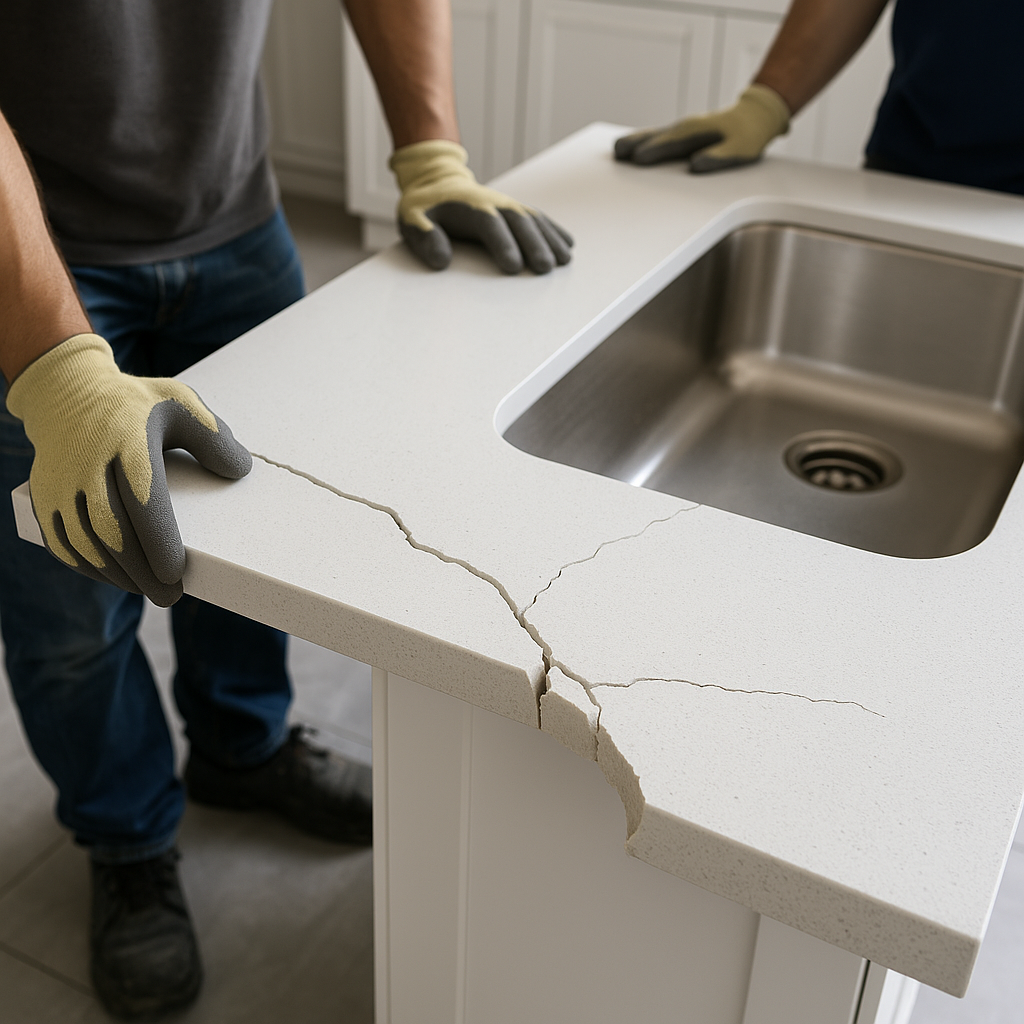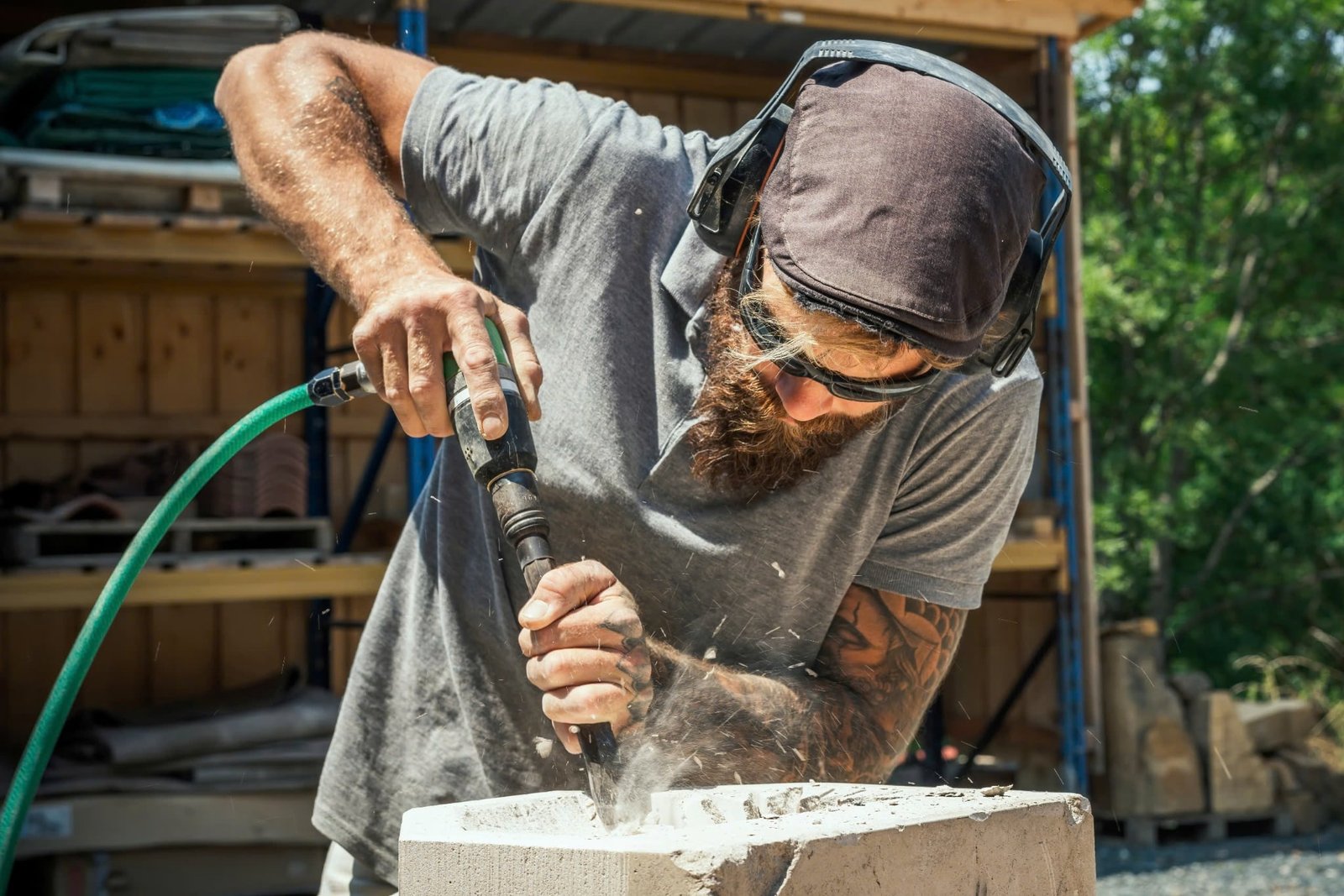
Cracks and breaks are among the most costly and frustrating issues that can occur during a countertop installation
Cracks and breaks are among the most costly and frustrating issues that can occur during a countertop installation. Whether you’ve chosen granite, quartz, or another premium surface, even the smallest structural failure can compromise your kitchen’s aesthetics and functionality. Worse yet, these mishaps often require full countertop replacement or extensive countertop repair, both of which drive up project costs.
In this article, we explore the most common causes of cracks and breaks during kitchen countertop installation, how to avoid them, and what to do if they occur. Whether you’re a homeowner planning a renovation or a contractor looking to prevent installation issues, this guide offers valuable insights into successful and stress-free installations.

Why Countertops Crack: Understanding the Risk
Countertops, especially those made from stone or engineered materials, are strong—but not invincible. Their strength depends on proper handling, structural support, and correct installation methods. Without these, cracks can occur before, during, or after installation.
Some causes are visible immediately, while others develop over time due to stress or structural movement. Recognizing these risk factors early helps ensure a smooth kitchen countertop fitting process and extends the life of your surface.
1. Improper Handling and Transportation
The issue: Countertops—particularly granite and quartz—are heavy and brittle. One wrong move during loading, lifting, or carrying can lead to cracks along weak points.
How it happens:
- Carrying slabs flat instead of upright (they’re strongest when vertical)
- Dropping or bumping into walls or corners
- Using inadequate equipment or too few people
Prevention:
- Use A-frame carts and vacuum lifters
- Always move slabs vertically with edge support
- Have trained professionals handle the material
Learn more about the risks of doing it yourself in Why Do Countertop Installation Errors Often Happen During DIY Projects?
2. Lack of Proper Support or Bracing
The issue: Unsupported overhangs, large spans, or weak cabinets can cause the slab to flex or crack under its own weight.
Common scenarios:
- No corbels under overhangs greater than 12 inches
- Unsupported corners or sink cutouts
- Uneven cabinets during kitchen countertop installation
Prevention:
- Reinforce spans with brackets, steel rods, or corbels
- Ensure cabinets are level and solid
- Add plywood sub-tops where needed
3. Incorrect Sink or Appliance Cutouts
The issue: Cutouts for sinks, cooktops, or outlets weaken structural integrity—especially near corners or edges.
Why it happens:
- Overly thin material left around the edges
- Sharp internal corners instead of rounded ones
- Improper polishing or grinding techniques
Prevention:
- Round inside corners of all cutouts to distribute stress
- Avoid cutting close to the slab’s edge
- Use a template and professional tools
For guidance on strategic sink placement, visit Where Should the Sink Be Placed During Countertop Installation?
4. Thermal Shock and Heat Exposure
The issue: Extreme temperature changes—such as placing a hot pan directly on the countertop—can cause thermal shock, leading to cracks.
Materials at risk:
- Quartz (resin can melt or discolor)
- Granite (can crack under direct, sudden heat)
Prevention:
- Always use heat pads or trivets
- Avoid installing countertops near heat vents without a buffer
- Educate users on material limitations post-installation
5. Uneven Cabinets or Base Surfaces
The issue: Installing a slab on an uneven or sagging base causes tension points that can lead to stress cracks over time.
Symptoms:
- Minor cracks forming at the corners
- Gaps between countertop and cabinet
- Slab rocking or tipping at the edges
Prevention:
- Use a laser level before installation
- Shim cabinets and check for sags
- Never install on warped or unstable surfaces
6. Over-Tightened Fasteners or Brackets
The issue: Fasteners used to secure countertops to cabinets or walls can crack the stone when over-tightened or poorly positioned.
What happens:
- Stone compresses under screw pressure
- Cracks form at mounting points, often near sinks
Prevention:
- Use flexible silicone adhesive instead of hard mechanical fasteners
- Avoid overtightening bolts or screws
- Allow for expansion and contraction
7. Poor Seaming Techniques
The issue: Improper seaming during multi-piece granite countertop installation or quartz countertop installation can create weak joints that crack under stress.
Common mistakes:
- Mismatched veining or grain
- Lack of epoxy or seam brackets
- Seams placed too close to high-stress areas
Prevention:
- Use professional seaming tools and tinted adhesives
- Place seams away from cooktops, sinks, or unsupported edges
- Hire experts with experience in pattern matching
8. Low-Quality Materials or Thin Slabs
The issue: Using thinner slabs (e.g., 2cm instead of 3cm) without proper support makes countertops more susceptible to breaks.
How it happens:
- Inferior quality materials may have hidden fissures
- Thinner slabs are more vulnerable to bending or cracking
Prevention:
- Choose 3cm slabs for high-use areas
- Inspect slabs before cutting
- Invest in higher-quality materials, even if countertop installation cost is slightly higher
9. Ignoring Expansion and Flex Gaps
The issue: Installing a countertop too tightly against walls, cabinets, or appliances leaves no room for expansion or movement.
Results:
- Cracking when materials expand or shift
- Popped seams or edge chipping
Prevention:
- Leave 1/8-inch expansion gaps near walls and corners
- Fill with flexible caulk, not rigid adhesive
- Consider natural house settling and seasonal shifts
What to Do If a Crack Happens
Minor Hairline Cracks:
- Can often be filled with epoxy or resin
- May require countertop resurfacing for visual consistency
Structural Cracks:
- Likely requires professional countertop repair
- In some cases, total countertop replacement is necessary
When to Call a Professional
Preventing cracks starts with expert installation. If your kitchen layout includes large islands, cutouts, or premium materials, hire a reputable countertop installation near me service to:
- Assess structural needs
- Handle materials properly
- Seam, cut, and finish with precision
You’ll reduce risks and increase the longevity of your investment.
Final Thoughts
Cracks and breaks during countertop installation are avoidable but require meticulous planning, the right materials, and proper handling techniques. From reinforcing cabinets and sink cutouts to choosing the right slab thickness and seam placement, each step plays a role in preventing damage.
Whether you’re planning a granite countertop installation, a quartz upgrade, or a full kitchen countertop installation, partnering with experienced professionals is often the best way to safeguard your investment.
For additional prevention strategies, read How Can You Prevent Common Countertop Installation Mistakes?

